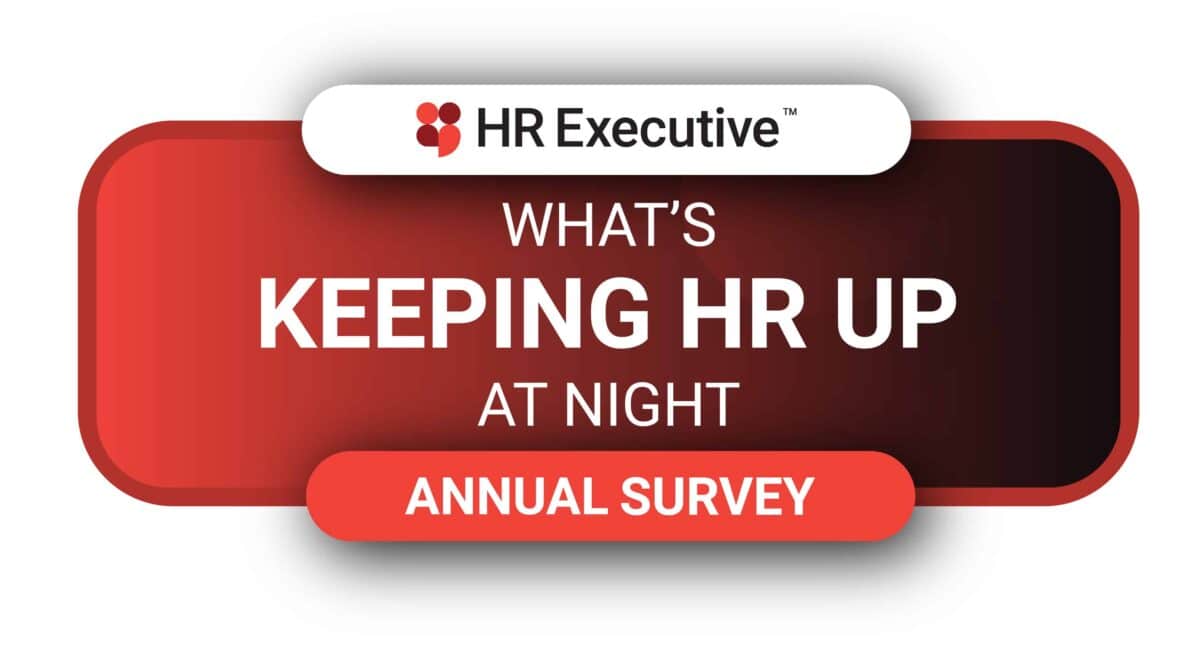In HR Executive’s recent What’s Keeping HR Up at Night? research, a majority of the 400 HR professionals surveyed agreed: Developing and executing employee retention strategies is the most vexing aspect of their work.
Nearly one-third of the respondents cited hiring and retaining key talent as their function’s biggest challenge. In 2019, the same survey put that figure at more than 50%, but retention was far outpaced the following year by pandemic-related concerns. Now, five years after COVID, employee retention strategies are again capturing a significant share of HR’s attention—an increasingly complex focus, as talent shortages, AI advancements and global uncertainty reshape the labor market.
 “With the ongoing competition for skilled workers, HR teams are struggling to attract and retain top talent, particularly in industries with high demand for specialized skills,” one survey respondent wrote.
“With the ongoing competition for skilled workers, HR teams are struggling to attract and retain top talent, particularly in industries with high demand for specialized skills,” one survey respondent wrote.
“Attracting and retaining the right talent is critical for driving organizational success,” another said. “In today’s competitive job market, finding individuals with the right skills and cultural fit is increasingly challenging.”
Mission critical
Sarah Fyfe, chief people officer at telepsychiatry company Iris Telehealth, says that, despite the massive shifts in the talent management space in recent years, the most effective employee retention strategies help employees align with a purpose.

“From my experience, employees who stay feel valued, supported and work in alignment with the organization’s mission,” she says.
At Iris, the company’s mission centers on expanding patient access to behavioral health supports. “That attracts and helps us retain the most talented of individuals,” Fyfe says. “Because it’s more than just a job.”
The HR team at Iris works to create a thread throughout the entire employee lifecycle that highlights how workers are creating meaningful impacts for patients, their families and communities.
“There’s a tremendous problem in our country and globally of people suffering mental illness who can’t get access to care, and that creates a strong pull from a retention standpoint, as well as recruiting,” Fyfe says.
Working toward a strong purpose is going to be even more important for employees in the coming years. Deloitte research recently found, for instance, that nearly 90% of millennial and Gen Z workers say having a strong purpose at work is important to job satisfaction.
Jessi Marcoff, chief people officer at electronic bill payment solutions InvoiceCloud, recently told HR Executive that HR needs to help make clear to all employees how their “day-to-day activity contributes to the greater good that a company is working toward.” By doing so, she says, organizations will “not only create more inspired teams with lower turnover but also reaffirm their own missions.”
HR as an enabler of growth
Apart from connecting employees with purpose, Fyfe says, other pillars of effective employee retention strategies involve a focus on building trust with and enabling the workforce to grow.
Ensuring roles are well-defined, growth trajectories are visible and that employees have access to robust learning opportunities—Iris creates training in-house, Fyfe says, that helps employees develop skills specific to advancing within the company—can help workers “take ownership” of their mobility and drive satisfaction.
Skills development is a key piece of the employee retention strategy at workplace agility software provider Cornerstone OnDemand, says Carina Cortez, chief people officer.
“One of the main reasons people leave an organization is because of that lack of—or perceived lack of—professional development,” Cortez says.
Cornerstone’s recent research found that nearly three-quarters of workers are eager to know about job prospects at their current employer; without that visibility, more than 60% would consider leaving their job.
Simply knowing that they have access to opportunity within the company—not necessarily taking it—can make the difference, Cortez emphasizes. From there, HR and managers should focus on “enablement”—giving workers the tools to pursue the development meaningful to the career path they envision for themselves.

Apart from Cornerstone’s robust internal talent marketplace platform, Cortez says, the organization also leverages its Achieve program. The self-paced learning modules present individual contributors who are thinking about moving into a management role with a range of courses to help them develop necessary skills and explore the realities of working as a people manager. From there, participants work with a cohort in instructor-led sessions, ultimately completing the program in about six months.
Recipes for coaching
“It helps you fortify the skills and gives you a flavor [of being a people manager] before you jump in,” Cortez says.
On a 5-point scale, participants rated the program a 4.7 on effectiveness.
Managers’ ability to effectively lead career coaching conversations is now among their most important contributions to employee retention, says James Glover, CEO of Flint Learning, a provider of personalized learning solutions.
HR should be “giving them opportunities to practice” this skill, he says. Flint Learning, for instance, provides activity-based training for employee learning, an approach that Glover says HR can leverage to prepare managers for the heightened need for coaching.
“They need very specific training for how to execute a career conversation,” Glover says. “When you make it something they can turn into activities they can practice, something that’s fully described, they can follow a recipe.”
The strategy also lends itself well to measurement, creating a more direct line between manager effectiveness and retention.
Data’s role in employee retention
For instance, an organization can simulate A/B testing by providing career coaching training to half of its managers and then measuring, including through exit interviews, the number of departing employees who reported to managers who had undergone such training.
“You can measure what you’re providing a recipe for in a much more coherent way across the system to see whether it’s working,” Glover says.
Data will also be critical to retention efforts as AI increasingly finds its place in learning and development. AI is enabling HR to personalize employee learning in a way that can drive true employee growth, Glover says, likening the shift to childhood education.

“In a classroom of 21 kindergarteners, you’re not going to treat them all the same way because they all learn a different way and go at a different speed, so you have to customize lesson plans for each,” he says.
The most effective teachers—and similarly, managers and leaders—use data from personalization to continuously improve.
“If you’re using AI to teach 50 people differently, you don’t just get that benefit for those people, you get the benefit of running 50 different experiments, seeing what really works to make them better,” Glover says. “Companies that figure out how to leverage AI can create a virtuous cycle of learning, which will be a big factor for retention.”
Centering empathy in employee retention strategies
While professional development can be furthered through tech-powered talent marketplaces and career pathing tools, managers will be the real lynchpin for whether employees feel that their growth is supported in the long term.
“Managers have to continuously engage with employees,” Cortez says. “I don’t think anything is going to take the place of that.”
On her team, for instance, Cortez has one direct report to whom being visible to the executive team is important, and another who is eager to attend and speak at industry conferences.
“I wouldn’t know that,” she says, “if I’m not talking to them. Having that opportunity to understand all my direct reports is really, really helpful.”
Cortez says she can use such insights in cooperation with the talent marketplace to keep employees questioning their skills and direction: What course do you want to take? Do you want to move sideways, or do you want to move up? What skills do you want to develop?
Managers can be the face who demonstrates to employees that the company cares about them and their futures, Glover adds.
“But you have to actually care; good managers are the ones who care,” he says. It will be incumbent on HR, he adds, to identify, recruit and train high-potential future managers who have a genuine interest in the success of both employees and the organization.
“We have to be not just promoting people on the basis of competency, but also on what will make them successful at the next level, which includes some character traits,” Glover says. “At the end of the day, whether managers genuinely care about other people will be a huge factor in whether the organization will be successful at retaining its people.”
A wellbeing-focused transformation
Managers are playing an increasingly pivotal role in effective employee retention strategies, in part, because of the outsized impact of employee wellbeing on turnover, says Alex Powell, director of client cultural insights at Reward Gateway | Edenred, an employee engagement platform provider.
The organization’s recent research found that about 50% of employees surveyed would rather work for a company that cares about their wellbeing than have a 10% pay raise—compared to 44% who preferred a wellbeing focus last year. The value employees place on wellbeing is likely to only increase, as the survey found that as much as 58% of younger workers would value wellbeing support over higher pay.

“[Wellbeing support is] something that’s increasingly part of the employee calculus about where they’re going to work, how long they’re going to stay and how hard they’re going to work,” Powell says.
Doubtlessly, that shift accelerated during the pandemic, she says, as both employers and employees started taking mental health “very, very seriously.” Younger generations are also more accustomed to discussing wellbeing, and they are bringing into the workplace heightened expectations for employer support—“and managers may or may not be ready for it,” Powell says.
Managers as therapists?
Recent research from Reward Gateway | Edenred found that managers report being more stressed than frontline workers who were surveyed—unsurprisingly, Powell says. However, the new dimension to this conversation is that 71% of managers surveyed feel a personal responsibility for their teams’ wellbeing.
Read more: Middle managers: How HR can support these overworked leaders
“If I’m in Gen X, I came into a workforce where we weren’t supposed to talk about our feelings. Now, managers are expected to help employees actually manage those feelings,” Powell says.
The organization found that about two-thirds of employees today say they’re comfortable bringing up issues related to their physical health in the workplace, and nearly 60% are OK talking about mental health challenges. Almost half of those surveyed cite being comfortable talking about financial health at work, a figure that has steadily risen.
Managers—who are already facing heavy workloads and navigating rapid change—require more comprehensive support from HR to lead in this changed environment, Powell says. In particular, they need the tools to become comfortable having what may be challenging conversations with their reports and should also be well-versed in the benefits the organization offers to support employee wellbeing and the resources with which they can connect their teams.
“The company needs to support managers because the managers are supporting the people—whether they feel capable and comfortable with that or not,” she says.
The post Must-haves for employee retention success in today’s climate appeared first on HR Executive.